Astrid Lindgren – A Critical Study
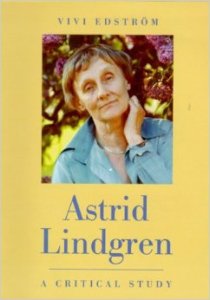 There’s no way to accurately sum up this 327-page book about Astrid’s writing. It was an exhausting read, but an excellent one. Written by Vivi Edstrom and translated by Eivor Cormack, it was published originally as Astrid Lindgren – Vildtoring och lagereld (1992). I was curious how the English title compared to the Swedish title, so I did an online translation. It came up with this: Astrid Lindgren – Vildtoring and Campfire. Uh huh . . . well, so much for that.
There’s no way to accurately sum up this 327-page book about Astrid’s writing. It was an exhausting read, but an excellent one. Written by Vivi Edstrom and translated by Eivor Cormack, it was published originally as Astrid Lindgren – Vildtoring och lagereld (1992). I was curious how the English title compared to the Swedish title, so I did an online translation. It came up with this: Astrid Lindgren – Vildtoring and Campfire. Uh huh . . . well, so much for that.
The book gives a short overview of Astrid’s writings focusing on the following groupings:
- “Adventure and Apple Blossoms”
- Britt-Mari and Kerstin books which, to my knowledge, have not been translated to English
- Kati books
- Bill Bergson books
- Rasmus and the Vagabond
- Rasmus, Pontus, and Toker (not translated to English)
- “From Bullerby Village to Salt Crow Island”
- Noisy Village books
- Lotta books
- Madicken books
- Seacrow Island
- “Humor and Farce”
- Pippi Longstocking books
- Karlsson books
- Emil books
- “Reality and Vision”
- Mio, My Son
- The Brothers Lionheart
- Ronia, the Robber’s Daughter
I could not possibly sum up everything I learned from this book, but what I can do is make a list of super-interesting things that I want to remember:
- Oskar from Rasmus and the Vagabond is mentioned as having the nickname “God’s Own Cuckoo” in this book, as opposed to the English translation of “God’s best friend.”
- This books lists Pippi’s name as “Pippilotta Provisonia Gaberdina Dandeliona Ephraimsdaughter Longstocking”
- Astrid Lindgren was talking about the difference between her two flying characters, Mr. Lilydale and Karlsson: “Mr. Liljonkvast [Lilydale] returned several years later, but then the rascal had gone and changed character, without asking me, and what he had turned into! Such an unbearable and willful character [Karlsson] that no one really wanted to see him! He, however, saw himself as a handsome, highly intelligent, and reasonably stout man in his prime. But he was no longer nice little Mr. Liljonkvast.”
- On The Brother Lionheart, Astrid Lindgren said, “Never before have I had such strong and spontaneous reactions to any book.”
- In regards to the younger brother Lionheart, whose name is Karl, it is noted that karl is a Swedish word for man. This adds depth not only to the younger Lionheart’s journey into growing up, but also to Karlsson-on-the-Roof, who is obsessed with how manly he is!
- On why she wrote Ronia the Robber’s Daughter, Astrid Lindgren said, “I wanted to get out into the forest.”
- “Ronia has some free-spirited predecessors in Lindgren’s works. She is related to Pippi Longstocking, Madicken, and, as already mentioned, the Amazon-like Eva-Lotta in the Bergson trilogy. These girls overstep the limits of convention, and they always do it outside the family, in a world of their own, with the threat close behind them.”
- Astrid Lindgren is explaining how she came to be a writer: “If it had not been snowing in Stockholm on a certain day in March 1944, it would probably not have ended that way.”
The most fun pages of the entire book, however, were a couple pages on names. It lists the Swedish names of characters and the English/American names. By now, I’ve mostly figured them out – Kalle Blomkvist/Bill Bergson, Madicken/Meg/Mardie, Jum-Jum/Pompoo, etc. – but a few of them absolutely floored me. For instance, Ronja/Ronia was once translated into English as Kirsty. KIRSTY. Thank you, world, for reverting to Ronia.
I also loved the list of books by Astrid Lindgren, but was somewhat dismayed to see only 35 books listed, not even half of what she wrote. Very few of her picture books were on the list or discussed. I would love to read more about her picture books. Alas.
This is a very fun read, but much more enjoyable because I have read almost all of the books discussed.
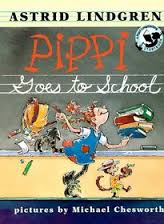 Pippi Goes to School is another Pippi storybook adapted from the original novels “with Astrid Lindgren’s assistance.” It’s one of the most fun Pippi stories and works well as a stand-alone storybook. It would be good for young readers who would see the humor in how not to act in school, or as a how-to manual for the little Emils and Pippis of the world. For those who have read the novels, there is no new material here, although the pictures by Michael Chesworth are quite fun.
Pippi Goes to School is another Pippi storybook adapted from the original novels “with Astrid Lindgren’s assistance.” It’s one of the most fun Pippi stories and works well as a stand-alone storybook. It would be good for young readers who would see the humor in how not to act in school, or as a how-to manual for the little Emils and Pippis of the world. For those who have read the novels, there is no new material here, although the pictures by Michael Chesworth are quite fun.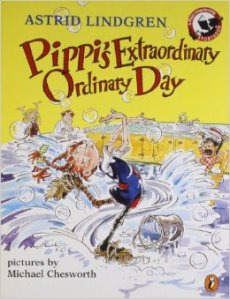

 This is another Pippi comic book. Its original name was Pippi Vill Inte Bli Stor Och Andra Serier. It was published in 2011 but the text is from 1957-1959. It was translated by Tiina Nunnally with pictures by Ingrid Vang Nyman.
This is another Pippi comic book. Its original name was Pippi Vill Inte Bli Stor Och Andra Serier. It was published in 2011 but the text is from 1957-1959. It was translated by Tiina Nunnally with pictures by Ingrid Vang Nyman.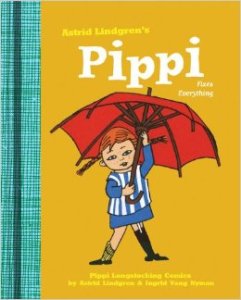 Published in Swedish as Pippi Ordnar Allt Och Andra Serier in 2010, the text was originally from 1957-1959. Pippi Fixes Everything was translated by Tiina Nunnally and illustrated by Ingrid Vang Nyman.
Published in Swedish as Pippi Ordnar Allt Och Andra Serier in 2010, the text was originally from 1957-1959. Pippi Fixes Everything was translated by Tiina Nunnally and illustrated by Ingrid Vang Nyman.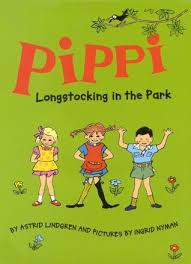 Pippi Langstrump i Humlegarden was published in 1949 and illustrated by Ingrid Nyman, one of my favorite illustrators in picture-book (not comic-book) format. This short story tells of the time Pippi, Tommy, and Annika moved to the city briefly to combat crime. They don’t just move to the big city, they tear down Villa Villekulla and bring it with them.
Pippi Langstrump i Humlegarden was published in 1949 and illustrated by Ingrid Nyman, one of my favorite illustrators in picture-book (not comic-book) format. This short story tells of the time Pippi, Tommy, and Annika moved to the city briefly to combat crime. They don’t just move to the big city, they tear down Villa Villekulla and bring it with them.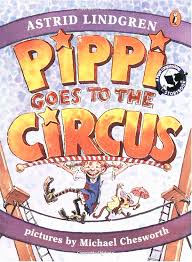 Pippi Goes to the Circus (1999) is another storybook version of a previously-told Pippi story. This book “has been excerpted, with Astrid Lindgren’s assistance, from two chapters in Pippi Longstocking.”
Pippi Goes to the Circus (1999) is another storybook version of a previously-told Pippi story. This book “has been excerpted, with Astrid Lindgren’s assistance, from two chapters in Pippi Longstocking.”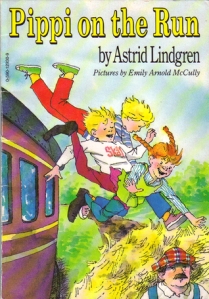

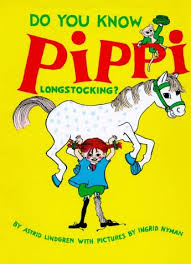 Do You Know Pippi Longstocking? is a book I almost didn’t include in the all-Astrid read of 2015. Of course it’s by Astrid Lindgren, but it’s a retelling of previous Pippi stories (translation by Elisabeth Kallick Dyssegaard). There’s really no new material here. But . . . it was published in 1947 under Kanner du Pippi Langstrump? and it’s a quick read, plus it’s listed on Astrid’s website, so whatever, here it is:
Do You Know Pippi Longstocking? is a book I almost didn’t include in the all-Astrid read of 2015. Of course it’s by Astrid Lindgren, but it’s a retelling of previous Pippi stories (translation by Elisabeth Kallick Dyssegaard). There’s really no new material here. But . . . it was published in 1947 under Kanner du Pippi Langstrump? and it’s a quick read, plus it’s listed on Astrid’s website, so whatever, here it is: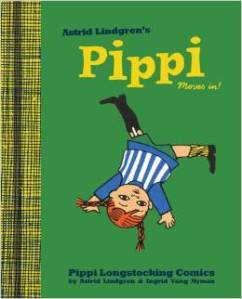 Pippi Moves In! (Pippi Flytarr in Och Andra Serier) is a comic-book style story that highlights select stories of Pippi. Most of the stories come from the original Pippi Longstocking, but some are from the other Pippi novels.
Pippi Moves In! (Pippi Flytarr in Och Andra Serier) is a comic-book style story that highlights select stories of Pippi. Most of the stories come from the original Pippi Longstocking, but some are from the other Pippi novels.